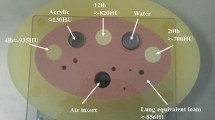Abstract
Objectives
To evaluate the impact of Adaptive Iterative Dose Reduction (AIDR) on image quality and radiation dose in phantom and patient studies.
Methods
A phantom was examined in volumetric mode on a 320-detector CT at different tube currents from 25 to 550 mAs. CT images were reconstructed with AIDR and with Filtered Back Projection (FBP) reconstruction algorithm. Image noise, Contrast-to-Noise Ratio (CNR), Signal-to-Noise Ratio (SNR) and spatial resolution were compared between FBP and AIDR images. AIDR was then tested on 15 CT examinations of the lumbar spine in a prospective study. Again, FBP and AIDR images were compared. Image noise and SNR were analysed using a Wilcoxon signed-rank test.
Results
In the phantom, spatial resolution assessment showed no significant difference between FBP and AIDR reconstructions. Image noise was lower with AIDR than with FBP images with a mean reduction of 40%. CNR and SNR were also improved with AIDR. In patients, quantitative and subjective evaluation showed that image noise was significantly lower with AIDR than with FBP. SNR was also greater with AIDR than with FBP.
Conclusion
Compared to traditional FBP reconstruction techniques, AIDR significantly improves image quality and has the potential to decrease radiation dose.
Key Points
-
This study showed that Adaptive Iterative Dose Reduction (AIDR) reduces image noise.
-
In a phantom image noise was reduced without altering spatial resolution.
-
In patients AIDR reduced the image noise in lumbar spine CT.
-
AIDR can potentially reduce the dose for lumbar spine CT by 52%.





Similar content being viewed by others
References
2007 CT market summary report (2007) Des Plaines, IL: IMV Medical Information Division
Brenner DJ, Hall EJ (2007) Computed tomography an increasing source of radiation exposure. N Engl J Med 357:2277–2284
Sodickson A, Baeyens PF, Andriole KP et al (2009) Recurrent CT, cumulative radiation exposure and associated radiation-induced cancer risks from CT of adults. Radiology 252:175–184
Smith-Bindman R, Lipson J, Marcus R et al (2009) Radiation dose associated with common computed tomography examinations and the associated lifetime attributable risk of cancer. Arch Intern Med 169:2078–2086
Berrington de González A, Mahesh M, Kim KP et al (2009) Projected cancer risks from computed tomography scans performed in the United States in 2007. Arch Intern Med 169:2071–2077
Mulkens TH, Bellinck P, Baeyaert M et al (2005) Use of an automatic exposure control mechanism for dose optimization in multi-detector row CT examinations: clinical evaluation. Radiology 237:213–223
Kalender WA, Buchenau S, Deak P et al (2008) Technical approaches to the optimisation of CT. Phys Med 24:71–79
Alkadhi H, Leschka S (2011) Radiation dose of cardiac computed tomography—what has been achieved and what needs to be done. Eur Radiol 21:505–509
Christner JA, Zavaletta VA, Eusemann CD, Walz-Flannigan AI, McCollough CH (2010) Dose reduction in helical CT: dynamically adjustable z-axis X-ray beam collimation. AJR Am J Roentgenol 194:W49–W55
Gervaise A, Louis M, Batch T et al (2010) Dose reduction at CT of the lumbar spine using a 320-detector scanner: initial results. J Radiol 91:779–785
Xu J, Mahesh M, Tsui BM (2009) Is iterative reconstruction ready for MDCT? J Am Coll Radiol 6:274–276
Hara AK, Paden RG, Silva AC, Kujak JL, Lawder HJ, Pavlicek W (2009) Iterative reconstruction technique for reducing body radiation dose at CT: feasibility study. AJR Am J Roentgenol 193:764–771
Thibault JB, Sauer KD, Bouman CA, Hsieh J (2007) A three-dimensional statistical approach to improved image quality for multislice helical CT. Med Phys 34:4526–4544
Gupta AK, Nelson RC, Johnson GA, Paulson EK, Delong DM, Yoshizumi TT (2003) Optimization of eight-element multi-detector row helical CT technology for evaluation of the abdomen. Radiology 227:739–745
Pontana F, Duhamel A, Pagniez J et al (2011) Chest computed tomography using iterative reconstruction vs. filtered back projection (part 2): image quality of low-dose CT examinations in 80 patients. Eur Radiol 21:636–643
Boedeker KL, McNitt-Gray MF (2007) Application of the noise power spectrum in modern diagnostic MDCT: part II. Noise power spectra and signal to noise. Phys Med Biol 52:4047–4061
von Falck C, Galanski M, Shin HO (2010) Informatics in radiology: sliding-thin-slab averaging for improved depiction of low-contrast lesions with radiation dose savings at thin-section CT. Radiographics 30:317–326
Prakash P, Kalra MK, Ackman JB et al (2010) Diffuse lung disease: CT of the chest with adaptive statistical iterative reconstruction technique. Radiology 256:261–269
Ghetti C, Ortenzia O, Serreli G (2011) CT iterative reconstruction in image space: a phantom study. Phys Med [Epub ahead of print]
Spangfort EV (1972) The lumbar disc herniation: a computer-aided analysis of 2,504 operations. Acta Orthop Scand Suppl 142:1–95
Silva A, Lawder H, Hara A, Kujak J, Pavlicek W (2010) Innovations in CT dose reduction strategy: application of the adaptive statistical iterative reconstruction algorithm. AJR Am J Roentgenol 194:191–199
Pontana F, Pagniez J, Flohr T et al (2011) Chest computed tomography using iterative reconstruction vs. filtered back projection (part 1): evaluation of image noise reduction in 32 patients. Eur Radiol 21:627–635
Mitsumori LM, Shuman WP, Busey JM, Kolokythas O, Koprowicz KM (2011) Adaptive statistical iterative reconstruction versus filtered back projection in the same patient: 64 channel liver CT image quality and patient radiation dose. Eur Radiol [Epub ahead of print]
Fazel R, Krumholz HM, Wang Y et al (2009) Exposure to low-dose ionizing radiation from medical imaging procedures. N Engl J Med 361:849–857
Tins B (2010) Technical aspects of CT imaging of the spine. Insights Imaging 1:349–359
Bohy P, de Maertelaer V, Roquigny A, Keyzer C, Tack D, Genevois PA (2007) Multidetector CT in patients suspected of having lumbar disk herniation: comparison of standard-dose and simulated low-dose techniques. Radiology 244:231–524
Author information
Authors and Affiliations
Corresponding author
Rights and permissions
About this article
Cite this article
Gervaise, A., Osemont, B., Lecocq, S. et al. CT image quality improvement using adaptive iterative dose reduction with wide-volume acquisition on 320-detector CT. Eur Radiol 22, 295–301 (2012). https://doi.org/10.1007/s00330-011-2271-7
Received:
Revised:
Accepted:
Published:
Issue Date:
DOI: https://doi.org/10.1007/s00330-011-2271-7




